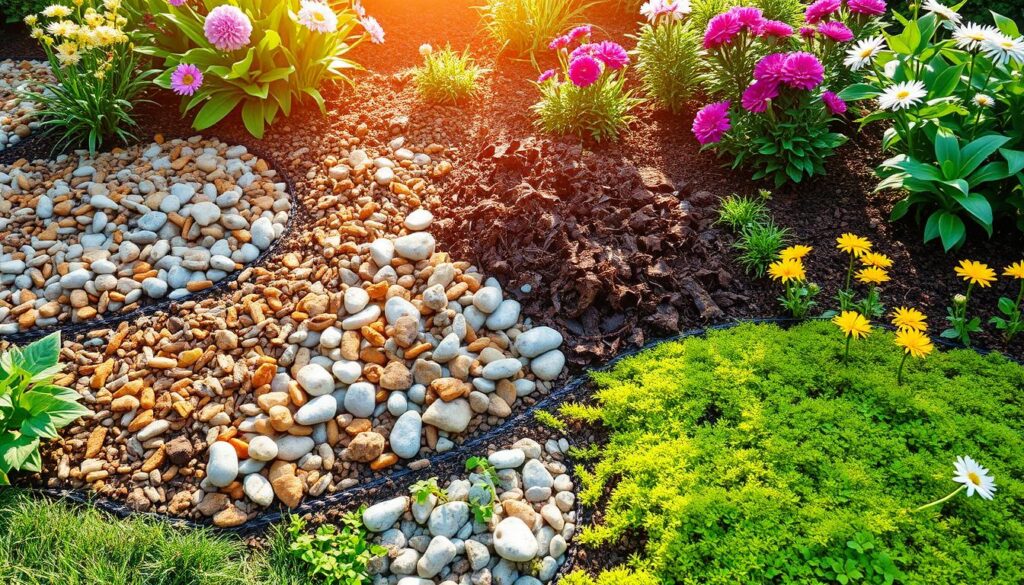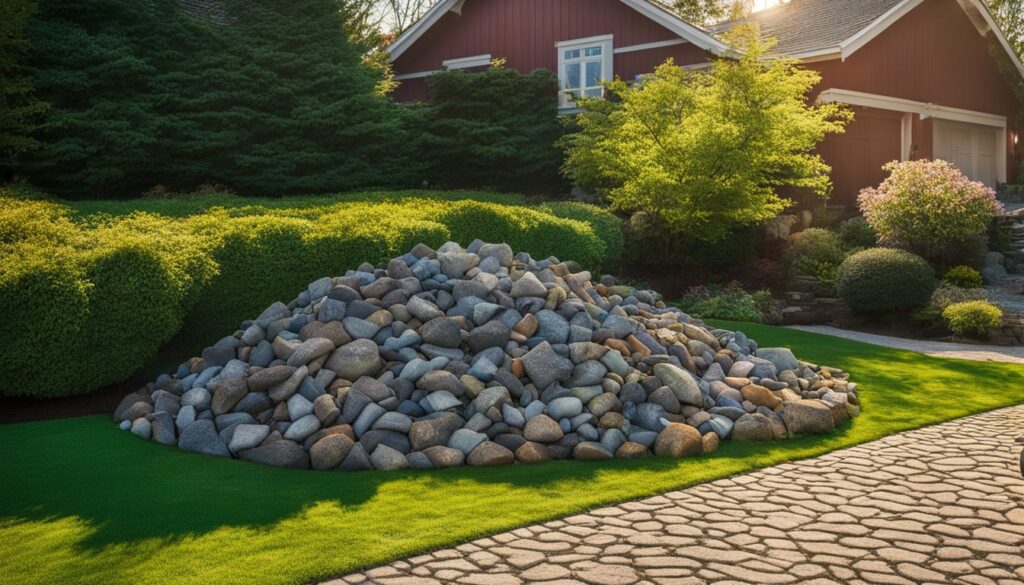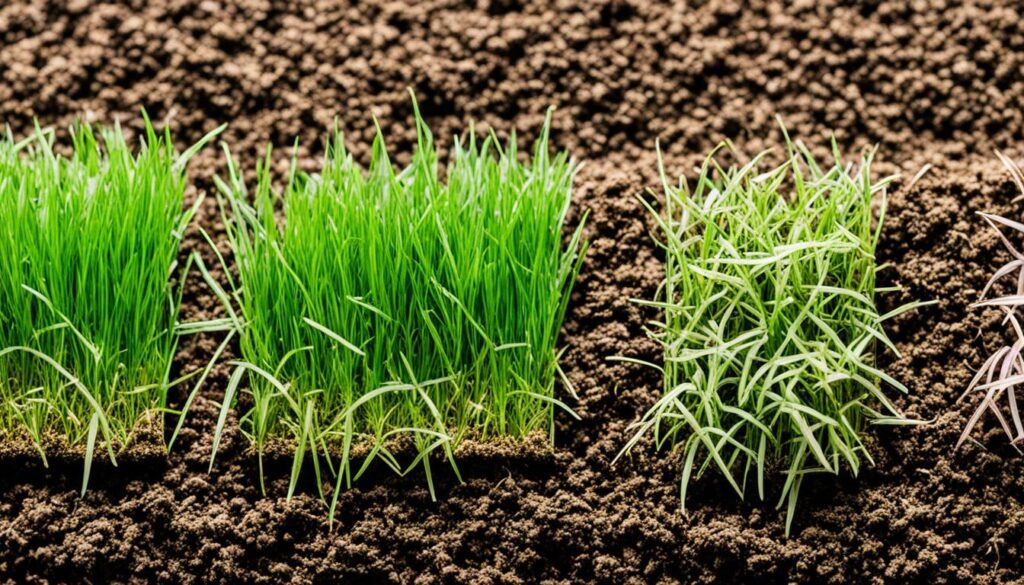About 80% of gardeners use landscaping fabric or alternatives to fight weeds. But, traditional landscaping fabric can harm soil health and balance. Gardeners are looking for eco-friendly ways to control weeds.
This article will look at better options for gardening. We’ll focus on materials that are good for plants and the soil. Let’s explore cardboard, burlap, ground cover plants, and other alternatives to synthetic landscaping fabric.
Key Takeaways
- Landscaping fabric is mostly made from woven polypropylene.
- Cardboard and burlap are biodegradable and eco-friendly alternatives.
- Ground cover plants add aesthetic value while controlling weeds.
- Straw mulch can effectively cover large gardening spaces.
- Wood chips decompose slowly, providing essential nutrients to soil.
- Bark mulch retains moisture and helps prevent plant diseases.
Understanding Landscaping Fabric
Landscaping fabric is key to keeping gardens healthy. It stops weeds and prevents soil erosion. This fabric is a woven cloth that lets air and water through but blocks sunlight to stop weeds.
Definition and Purpose
Landscaping fabric helps control weeds and organize garden beds. It’s made from materials like polypropylene or polyester. This fabric keeps soil stable and separates layers in the ground.
It’s a budget-friendly option for short-term projects. Gardeners find it great for keeping their landscapes tidy. But, remember, its weed control can vary over time.
Common Misconceptions
Many gardeners misunderstand landscaping fabric. Some think it’s a “set-it-and-forget-it” solution, but it’s not. It can cause water drainage problems and harm soil health over time.
Also, it doesn’t protect plants from the cold. It’s important to know these facts to manage your garden well.
What Can Be Used Instead of Landscaping Fabric
Many gardeners look for landscaping fabric alternatives to keep their gardens neat. There are many options that are good for the planet and work well. These materials stop weeds and prevent soil erosion, just like traditional fabric, but they also have extra benefits.
Overview of Alternatives
Looking into what can be used instead of landscaping fabric shows us some great choices. Each one has its own perks for your garden:
- Cardboard: It’s cheap and good for the earth. Cardboard stops weeds and helps the soil as it breaks down.
- Newspaper: Putting down newspaper can keep weeds away. It’s easy to find and use.
- Burlap: This natural option lets air and water get through. It also feeds the tiny creatures in the soil as it breaks down.
- Ground Cover Plants: These plants cost a bit more but stop weed seeds from growing by blocking sunlight.
- Straw: Straw is a mulch that makes the soil better and keeps weeds down.
- Wood Chips: These chips are good for the garden and look nice. They help keep weeds away.
- Permeable Pavers: These can be used with other methods to control weeds and stop erosion.
Using landscaping fabric alternatives makes gardens healthier. They make the soil better and support gardening that’s good for the planet. As I learn more about these options, I’ll see how they can make my gardening better.
Cardboard as a Weed Barrier
Cardboard is a great choice for keeping weeds away in gardens. It’s affordable and good for the planet. Using cardboard helps make soil healthier and keeps weeds down.
Advantages of Using Cardboard
Cardboard is biodegradable, which means it breaks down and adds nutrients to the soil. This helps with composting and makes plants healthier. Plus, you can often get cardboard for free, making it a budget-friendly option.
It’s also a sustainable way to control weeds. With the right steps, you can keep your garden weed-free without spending a lot.
How to Install Cardboard Effectively
To use cardboard as a weed barrier, start by laying down clean, unwaxed cardboard. Make sure to remove any tape, prints, or glue that could slow down its breakdown. Overlap the cardboard pieces by 8 to 12 inches for the best coverage.
Next, wet the cardboard before adding a layer of mulch or bark on top. This keeps the cardboard moist and helps smother weeds. It also keeps the soil healthy, ready for planting new plants.
Potential Limitations
While cardboard has many benefits, it’s not perfect. Experts worry about how it might affect air getting to the soil, which is important for soil life. This can make it tricky to use cardboard in all types of gardens.
Cardboard can also attract pests like termites, especially in certain areas. Before using it, it’s a good idea to talk to a pest expert. They can give you advice on how to use cardboard safely in your garden.
Newspaper as an Eco-Friendly Option
In my gardening journey, I’ve found using newspaper to be a great way to keep weeds away. It helps control weeds and gets better as it breaks down. Newspapers are a biodegradable choice, unlike traditional landscape fabrics.
Benefits of Newspapers in Gardening
Using paper in my garden has many benefits. It adds organic matter to the soil as it breaks down. This makes the soil better for plants. Plus, it’s affordable, often found cheap at local print shops.
End rolls of newspaper are a great find. Laying 4 to 8 layers creates a strong weed barrier. This simple method keeps my garden healthy.
Installation Tips for Newspapers
To make newspapers work best as a weed barrier, layer them carefully. Use 4 to 8 layers, skipping glossy and colored pages. Overlap the layers to cover everything, stopping weeds from getting light.
Adding mulch on top helps with insulation and keeping moisture in. This makes newspaper landscaping even more effective.
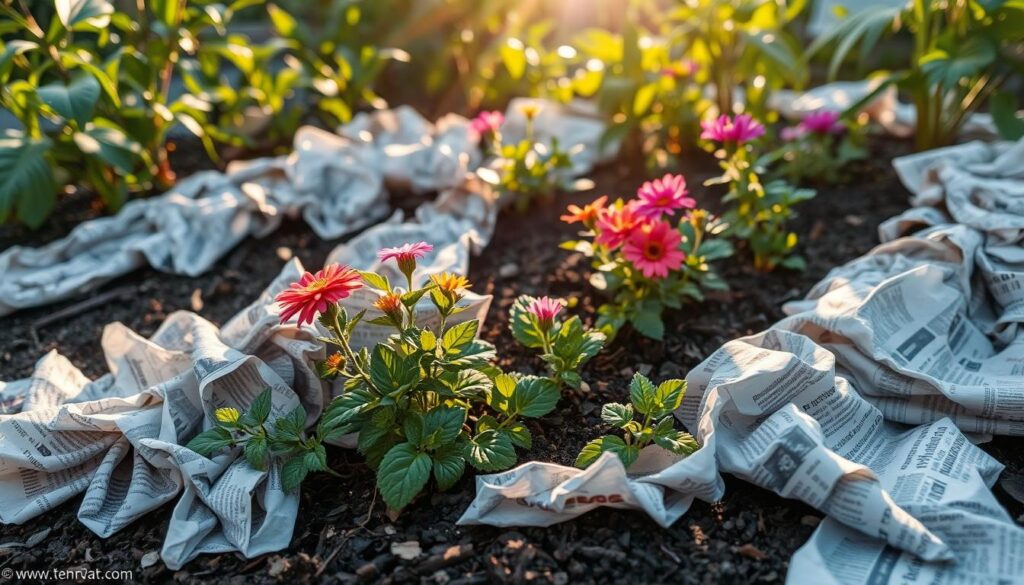
Burlap: A Natural Alternative
Burlap is a great choice for gardeners looking for an eco-friendly option. It’s made from natural materials that break down easily, helping soil life. This makes it a top pick over traditional garden fabrics.
Why Choose Burlap?
Burlap has many benefits. It controls weeds naturally and improves soil health as it breaks down. I’ve found it’s also more budget-friendly than some other fabrics. Using burlap helps me grow plants well and keeps weeds away.
Using Burlap in Your Garden
Putting burlap in your garden right is key. Lay it flat on the soil in your garden bed, making sure it covers the area you want to protect. Use stakes or soil to hold it down against wind or rain. As it breaks down, it adds nutrients to the soil and stops weeds from growing.
Considerations for Burlap Use
While burlap is a good choice, think about a few things first. It might not be as easy to find as other materials. Knowing how it works with your soil will help you see how well it works. Keeping an eye on it and maintaining it properly is important for it to work right in your garden.
Ground Cover Plants for Weed Control
In my gardening journey, I’ve learned that ground cover plants are great for controlling weeds. They block sunlight, stopping weeds from growing. While they might cost more to cover a big area, they have many benefits.
Best Types of Ground Cover Plants
Looking at ground cover plants for weed control, I see several good options:
- Creeping Thyme: It helps control weeds and smells nice.
- Elfin Thyme: Like creeping thyme, but not as effective against weed seedlings.
- Irish Moss: It makes the area look lush but needs regular care.
- Green Carpet Rupturewort: It’s tough in dry conditions and controls weeds well.
- Sedum Stonecrop: Does well in dry places and keeps weeds away.
- Periwinkle: Grows fast but might have disease issues.
- Strawberries: You can eat it and it helps fight weeds.
Long-Term Benefits
Using ground cover plants has given me lasting benefits. They cut down on weeding, making gardening more fun. They also improve soil health by adding nutrients as they break down.
Compared to landscape fabric, which can let weeds through, these plants are a better choice. They make my garden healthier and easier to maintain, with beautiful results.
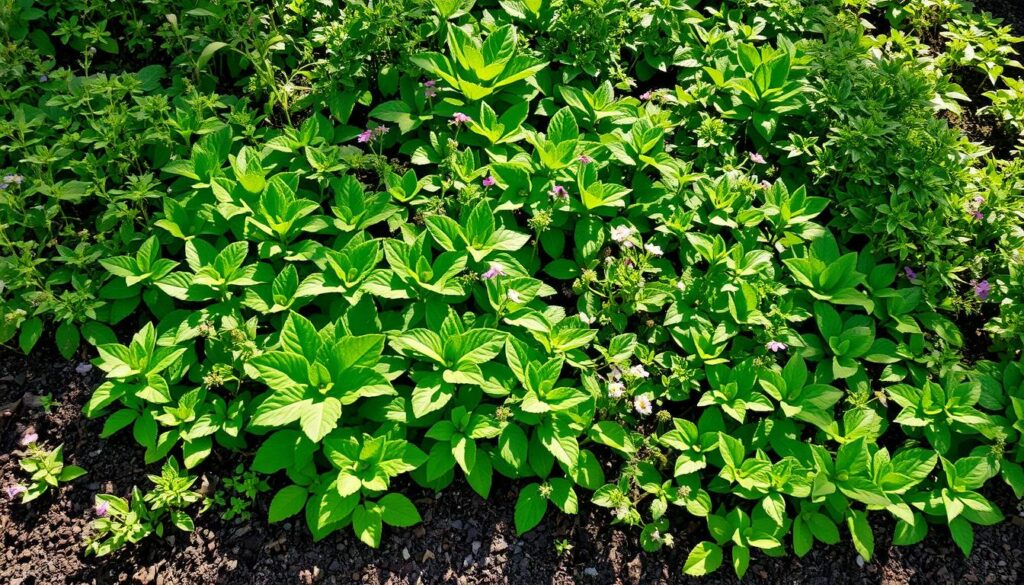
Choosing ground cover plants means a healthier garden and less work. It shows how important picking the right plants is in landscaping.
Utilizing Straw in Your Garden
Adding straw as mulch has changed how I deal with weeds and improve soil health. Straw is a natural choice that helps keep moisture in and adds nutrients to the soil. Knowing how to use straw right can greatly improve my gardening success.
Nutrient Benefits of Straw
Straw does more than just control weeds; it also adds important nutrients to the soil as it breaks down. This process adds organic matter, which helps improve soil structure and fertility. Using straw in my garden lets me enjoy many nutrient benefits of straw:
- Improved soil aeration, promoting healthy root development.
- Increase in biological activity, essential for nutrient cycling.
- Enhanced moisture retention, reducing the need for frequent watering.
Best Practices for Application
When starting with gardening with straw, it’s important to follow best practices. I make sure to pick high-quality, weed-free straw to keep my garden weed-free. Here are key tips for using straw as mulch:
- Apply at a depth of 3”-4” to effectively suppress weed growth and optimize moisture retention.
- Spread the straw evenly around plants, ensuring it does not touch the stems to prevent rot.
- Monitor the straw throughout the growing season; replenish as needed to maintain coverage.
By following these tips, I can fully benefit from straw. This approach makes garden care easier and supports a healthy, thriving garden.
Wood Chips and Bark Mulch
Wood chips and bark mulch are great for landscaping. They make gardens look better and help soil health. Many gardeners like wood chips for their many uses. These materials keep soil moist and add nutrients.
Why Wood Chips Make a Great Choice
Wood chips are a top choice for mulch. They stop weeds and improve soil as they decompose. In discussions, people shared tips on getting free wood chips for their gardens. It’s key to make the chips smaller for gardening. Checking the type of wood is also important to avoid harming plants.
Using Bark Mulch in Your Landscaping
Bark mulch is good for keeping moisture in the soil and feeding plants. In gardening groups, people talk about using Western forest tree bark for mulch. When adding bark mulch, think about how it affects plants and the environment. Avoid using bark from Black Walnut as it can harm plant growth.
Drawbacks to Consider
Wood chips and bark mulch have some downsides. Wood chips might draw insects and could bring diseases if not chosen right. Some trees, like cedar, can make soil too acidic. These mulches need to be refreshed over time. Also, don’t put wood chips near buildings as they can attract termites.
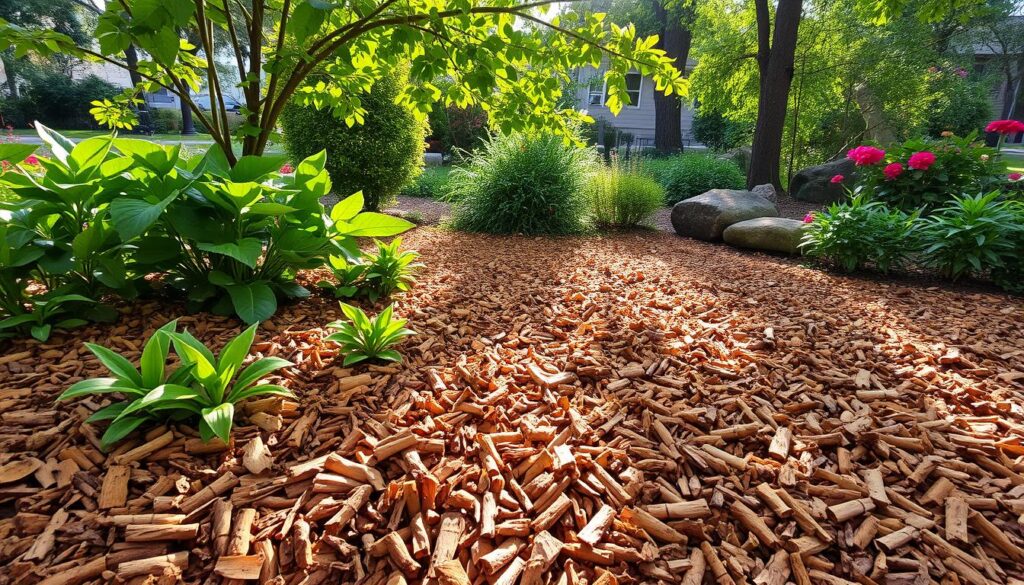
| Type | Advantages | Disadvantages |
|---|---|---|
| Wood Chips |
|
|
| Bark Mulch |
|
|
Alternative Organic Mulches
Looking into organic mulch alternatives can really boost gardening. Pine needles and shredded leaves are great choices because they’re easy to find and offer special benefits.
Pine Needles
Pine needles are a top pick for organic mulch. They’re light and simple to manage, which gardeners love. They keep the soil moist and don’t make it too acidic, perfect for acid-loving plants.
Using pine needles helps stop weeds and keeps the soil at a good temperature. Plus, they last about a year or two before you need more.
Shredded Leaves and Grass Clippings
Shredded leaves are great for the garden. They can be turned into a weed barrier and enrich the soil as they decompose. Adding them to the mulch improves the soil over time.
Grass clippings add more nutrients and help keep the soil moist. Mixing these with shredded leaves makes the soil richer and keeps the garden healthy.
These mulch alternatives make gardens healthier and are good for the planet. Using pine needles and shredded leaves means less work and lower costs. They’re easy to find and don’t need to be replaced often.
For more info on mulch options, check out this guide on landscape fabric alternatives.
Conclusion
Exploring landscaping fabric alternatives has shown me the power of eco-friendly gardening. Using cardboard, newspaper, wood chips, and organic mulches helps control weeds and enriches the soil. These materials break down naturally, making a sustainable landscape that thrives without harming the environment.
Choosing these sustainable solutions makes my yard healthier. Landscape fabric may control weeds at first but has downsides like degrading in sunlight and adding to plastic waste. By picking organic options, I’m fighting weeds and boosting soil health for gardening success.
These methods help me have a lush, vibrant garden. I encourage you to try these alternatives in your garden too. It leads to better weed control and a commitment to our planet. Let’s make gardens that are good for us and the earth.
FAQ
What is landscaping fabric?
Landscaping fabric is a special material that stops weeds from growing. It lets air and water get through but keeps sunlight out. This helps plants grow better.
Can I use cardboard as a weed barrier?
Yes, cardboard works well to keep weeds away. It breaks down and adds nutrients to the soil. Just make sure to remove staples and lay the pieces on top of each other.
How effective is newspaper in gardening?
Newspaper is a good choice for fighting weeds. It’s made from paper that breaks down and helps the soil. Use 4 to 8 layers for best results, but skip the glossy kind.
Why would I choose burlap over traditional landscaping fabric?
Burlap is a natural option that helps the soil by supporting good microorganisms. It’s perfect for gardens that focus on being organic, even if it’s harder to find than synthetic fabrics.
What are ground cover plants and how do they help with weed control?
Ground cover plants grow low to the ground and cover the soil. This stops weeds from getting sunlight. They also make the soil healthier and your garden look better.
How does straw benefit my garden?
Straw acts as a mulch that keeps weeds down and adds nutrients to the soil. It helps prevent soil erosion and keeps the soil moist, especially when it’s hot. Just pick straw without weeds for the best effect.
What advantages do wood chips and bark mulch offer?
Wood chips and bark mulch keep the soil moist and add nutrients. They also make your garden look nice. But, they might attract bugs and need to be replaced over time.
Are pine needles a good choice for mulching?
Yes, pine needles are a great mulch option. They keep the soil moist and don’t make it too acidic. They also break down slowly, giving your garden long-term benefits.
What can I do with shredded leaves and grass clippings?
Shredded leaves and grass clippings are excellent for mulching. They improve the soil’s structure and health. As they break down, they turn into rich organic matter that helps your garden thrive.

